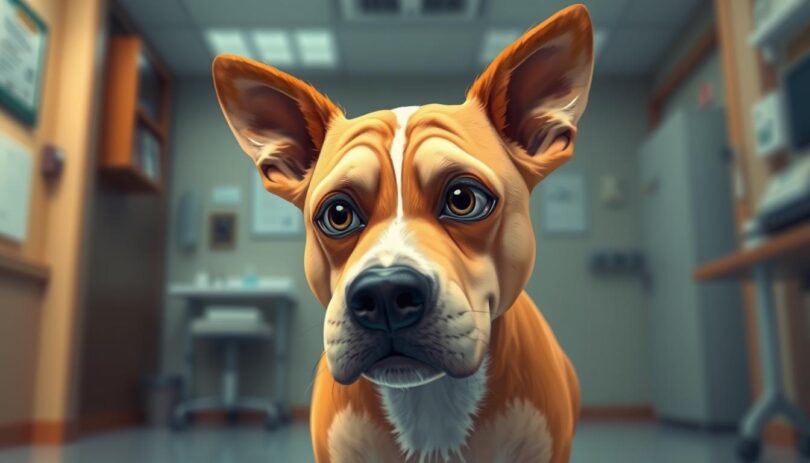Nearly 30% of pets treated for accidents involving vehicles or falls show signs of brain trauma. While many associate concussions with human athletes, our four-legged companions face similar risks after blunt force impacts. Head injuries in pets often go unnoticed until symptoms escalate, making timely care critical.
Traumatic incidents like collisions or tumbles can jolt a canine’s skull, damaging delicate neural pathways. Owners might mistake disorientation or lethargy for temporary stress, but these could signal deeper issues. Immediate veterinary attention is vital to prevent lasting harm.
Even minor head trauma demands scrutiny. A playful tumble off the couch or a bump during a hike might seem harmless, but internal swelling or bleeding can develop silently. Watch for unusual behaviors like loss of balance, dilated pupils, or vomiting—these warrant an urgent vet visit.
Understanding how to respond to potential brain injuries transforms pet guardianship. Early intervention improves recovery odds and reduces long-term complications. By recognizing warning signs and prioritizing professional evaluation, owners become proactive advocates for their furry family members’ well-being.
Understanding Concussions in Dogs
Head injuries in pets often occur suddenly, leaving owners scrambling to interpret subtle symptoms. Veterinary neurologist Dr. Jerry Klein describes a concussion as “a temporary disruption of brain function caused by rapid head movement.” Unlike visible wounds, these internal injuries require careful observation to detect.
What Is a Concussion in Canines?
A concussion involves brief unconsciousness or altered awareness after impact. Dr. John McCue notes that dogs may appear dazed or unresponsive for seconds before resuming normal activity. This makes diagnosis tricky—pets can’t describe dizziness or confusion like humans.
How Head Injuries Differ from Other Trauma
Blunt force to the skull affects the brain differently than fractures or muscle tears. Vets use neurologic exams to assess reflexes and coordination since scans alone might miss subtle damage. Even minor bumps can trigger swelling that worsens over hours.
Experts emphasize that delayed symptoms—like changes in appetite or sleep patterns—often reveal concussion severity. Early intervention prevents complications like seizures or permanent balance issues. Recognizing these distinctions helps owners advocate for timely care.
Can Dogs Get Concussions? Exploring the Risks
Accidental impacts remain a leading trigger for neurological issues in pets, with 1 in 4 head trauma cases linked to preventable household incidents. While any collision or fall poses dangers, certain scenarios heighten vulnerability.
Common Causes of Head Trauma in Dogs
Vehicle collisions account for 38% of brain-related emergencies, according to a 2023 veterinary study. Falls from balconies or furniture—especially in high-energy puppies—rank second. Rough play with larger animals or mishandling during grooming also contribute.
Dr. Sarah Wooten warns, “A 3-foot drop can jolt the skull of a small breed as severely as a car accident.” Even minor scrapes during walks may mask internal swelling. Owners often overlook subtle signs like temporary confusion or delayed reflexes after these events.
Breed and Size Considerations
Dome-headed breeds like Chihuahuas face higher risks due to thinner cranial bones. Conversely, brachycephalic dogs (e.g., Bulldogs) may experience compounded breathing issues post-injury. Large working breeds aren’t immune—their active lifestyles increase exposure to collisions.
Carried pets aren’t safer either. A Boston Terrier’s tumble from arms can cause whiplash-like brain injuries. Veterinary neurologist Dr. Melissa Boldan notes, “Size doesn’t shield against trauma—it changes how force distributes.”
Immediate vet evaluation after any impact helps detect silent bleeding or pressure spikes. Delaying care risks permanent coordination problems or seizures. Prioritizing swift professional assessment could save your companion’s quality of life.
Recognizing the Subtle Signs of Head Injury
Subtle shifts in behavior often hold vital clues after a pet’s accident. Unlike obvious wounds, brain trauma symptoms can emerge hours later, making careful monitoring essential. Owners who spot these early warnings significantly improve their companion’s recovery chances through timely care.
Behavioral Changes and Lethargy
A normally energetic terrier refusing playtime or a social pup hiding in corners could signal trouble. Veterinary reports highlight cases where lethargy was the only initial sign of damage. One dachshund’s uncharacteristic disinterest in food led to discovering brain swelling from a prior fall.
Physical Indicators: Vomiting, Balance Issues, and Pupil Differences
Repeated vomiting episodes often accompany head trauma, even without visible injury. Watch for stumbling, head tilting, or uneven pupil sizes (anisocoria)—a red flag requiring immediate treatment. A golden retriever’s temporary loss of coordination after a collision revealed hidden bleeding, emphasizing the value of prompt evaluation.
These signs may seem minor, but delaying care increases long-term risks. Documenting changes and seeking veterinary guidance quickly can prevent permanent damage and further complications. Trust your instincts—if something feels off, professional assessment makes all the difference.
Immediate Steps to Take When Head Trauma Is Suspected
Time becomes critical when a pet experiences head trauma. Quick, calm action can prevent complications and improve outcomes. Follow these evidence-based protocols to assess and stabilize your companion before professional care.
Evaluating Your Dog’s Condition at Home
Check responsiveness by calling their name and observing reactions. Look for dilated pupils, uneven eye sizes, or difficulty tracking movement. Test balance by encouraging gentle walking—stumbling or circling suggests neurological issues.
Monitor for nausea or vomiting, even hours after impact. Note changes in breathing patterns or unusual vocalizations. Avoid sudden movements or loud noises that might worsen disorientation. Keep a written record of symptoms for your vet.
How to Safely Transport Your Dog to the Vet
Stabilize the head and neck using a flat surface like a board or folded blanket. Small breeds benefit from secure wrapping in a towel, while larger canines need firm support under their torso. Keep the head elevated 15-30 degrees to reduce swelling risks.
Minimize movement during transit by placing pets in a carrier or confined vehicle space. Avoid curves or sudden stops that could jostle their skull. Never offer food/water until cleared by a professional—this prevents choking if reflexes are impaired.
Even subtle signs warrant an urgent visit. Traumatic brain injury symptoms often evolve slowly, making early veterinary assessment non-negotiable. Prioritize speed and safety to protect your companion’s neurological health.
Veterinary Diagnosis and Treatment Options for Dog Concussions
Diagnosing a concussion in dogs requires a blend of advanced tools and expert observation. Vets start with a neurologic exam, checking reflexes, eye movements, and coordination. These tests help pinpoint areas of brain injury while ruling out other conditions.
Uncovering Hidden Damage
Blood pressure monitoring often reveals swelling risks, while pupil response tests assess consciousness levels. Imaging like CT scans or MRIs might follow if the concussion may involve fractures or bleeding. Early detection prevents secondary issues like fluid buildup or oxygen deprivation.
Treatment focuses on stabilizing vital functions. IV fluids maintain hydration, and oxygen therapy supports healing in severe cases. Vets may prescribe rest in dim environments to reduce sensory stress. One study showed 80% of dogs recover fully when treatment begins within 6 hours of injury.
If you suspect dog head trauma, act fast—delayed care worsens outcomes. Regular checkups track recovery progress and catch late-emerging symptoms. Trusting veterinary expertise gives injured pets their best shot at regaining normal function.
Preventing Concussions: Safety Tips for Dog Owners
Proactive measures significantly reduce head injury risks in pets. Simple adjustments to daily routines and environments create safer spaces for active companions. Focus on minimizing hazards while maintaining opportunities for healthy play.
Managing Exposure to High-Risk Situations
Leashes and harnesses prevent darting into traffic, a leading cause of car accidents involving pets. Secure backyard fences eliminate escape routes near roads. For urban dwellers, avoid retractable leads in busy areas—opt for fixed-length options instead.
Monitor playdates with larger animals to prevent rough collisions. Use padded mats under climbing structures for small breeds prone to falls. Avoid high surfaces like beds or tables where jumps could cause dog injuries.
Learn to spot early signs like delayed reactions or unsteady movements. Quick recognition of these symptoms reduces the risk of severe loss consciousness. Document changes in behavior immediately and share details with your vet.
Annual check-ups help identify vulnerabilities like thin skull bones in certain breeds. Pair consistent veterinary care with home safety audits—secure loose objects and block stair access for puppies. Prevention builds a foundation for long-term well-being, shielding pets from traumatic brain injuries.
Expert Insights on Treating and Managing Canine Head Trauma
When brain injuries strike, expert guidance becomes a lifeline for concerned owners. Veterinary neurologists stress that early action often determines recovery speed and long-term outcomes. Recognizing subtle shifts in behavior paired with professional care creates the best path forward.
Veterinary Advice for Early Intervention
Dr. Amy Fox emphasizes, “The first 24 hours post-injury are critical—delayed care risks permanent damage.” Her team documented a Border Collie’s full recovery after owners noticed uneven pupils post-car accident and rushed to the clinic. Continuous monitoring for altered consciousness or unusual reflexes helps catch complications early.
Dr. Jerry Klein advises pet parents to track changes hourly: “Note appetite shifts, sleep patterns, or uncharacteristic anxiety.” One case involved a terrier whose vomiting 8 hours after a fall revealed hidden swelling. Immediate IV treatment prevented seizures.
Follow-up care proves equally vital. Dr. John McCue outlines, “Weekly checkups for 3-4 weeks detect late-emerging issues like balance disorders.” Collaborative plans between owners and veterinarians—including rest protocols and symptom journals—boost healing. A Dachshund’s full rebound after stairway trauma showcased this teamwork.
Trusting veterinary expertise ensures pets receive tailored solutions. From medication schedules to environmental adjustments, professionals guide each step. Quick decisions paired with attentive home care turn worrisome injuries into manageable recoveries.
Parting Thoughts on Protecting Your Dog’s Brain Health
Protecting your pet’s neurological well-being starts with awareness and action. Recognizing subtle signs like uneven pupils or balance changes can prevent minor injuries from becoming lifelong challenges. Quick veterinary visits after accidents remain the strongest defense against swelling and hidden damage.
Responsible ownership means monitoring recovery closely—even weeks post-injury. Schedule follow-up exams to check neck stability and track pupil responses, as delayed swelling sometimes surfaces days later. These steps help vets adjust treatment plans before complications arise.
Preventative strategies matter just as much as urgent care. Secure home environments reduce collision risks, while harnesses minimize neck strain during walks. Pair these habits with annual check-ups to catch vulnerabilities early.
Every informed decision you make strengthens your companion’s future. From swift injury responses to consistent health monitoring, your vigilance builds a safer, healthier life for them. Knowledge truly becomes power when safeguarding their brightest days ahead.
FAQ
Are smaller breeds more prone to head injuries?
Yes. Toy breeds like Chihuahuas and brachycephalic dogs like Pugs face higher risk due to skull structure and size. Even minor falls can cause traumatic brain injury in lightweight pets.
Can vomiting indicate a concussion?
Sudden nausea or repeated vomiting after head trauma often signals neurological distress. Combined with disorientation or loss of balance, it warrants urgent veterinary care.
What exactly is a concussion in dogs?
A concussion refers to temporary brain dysfunction caused by head trauma, often from impacts like car accidents or falls. It disrupts normal neurological function but may not show immediate visible damage.










Leave a Comment